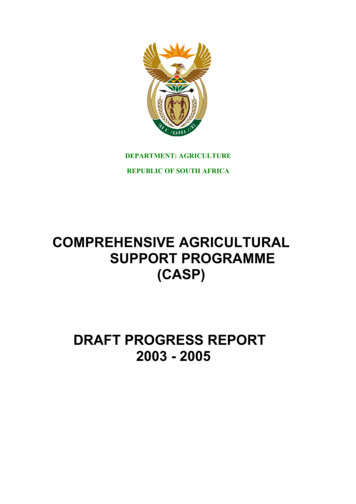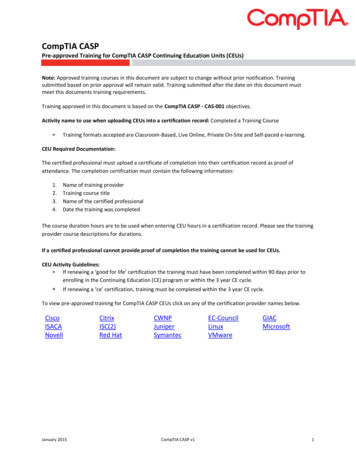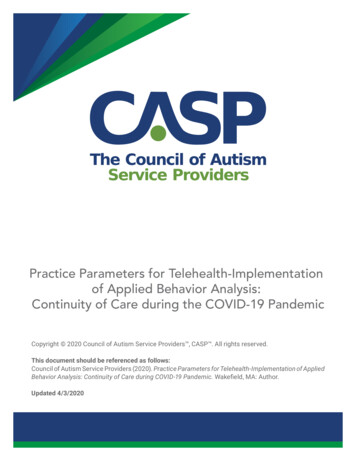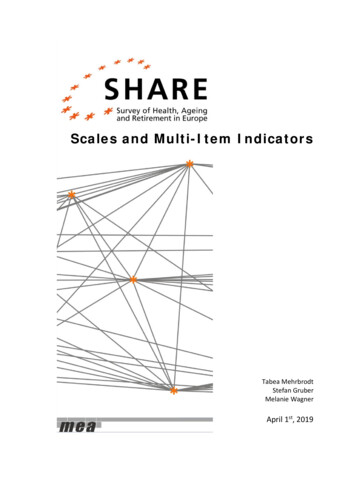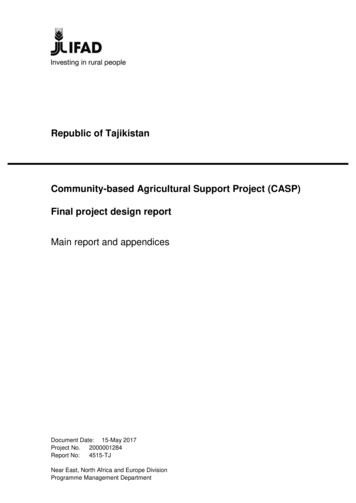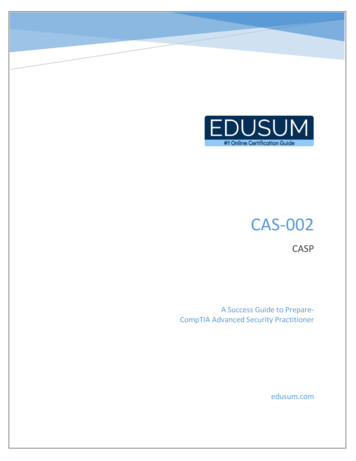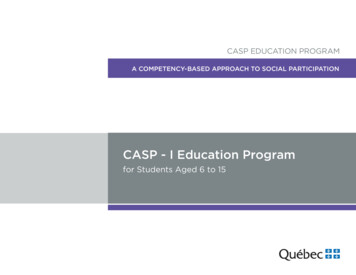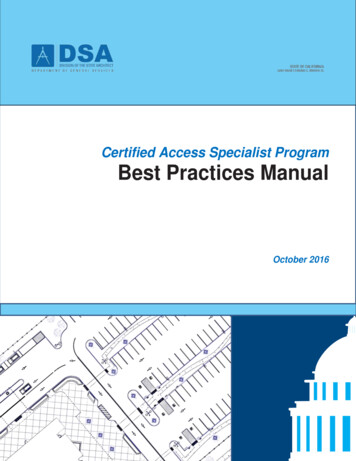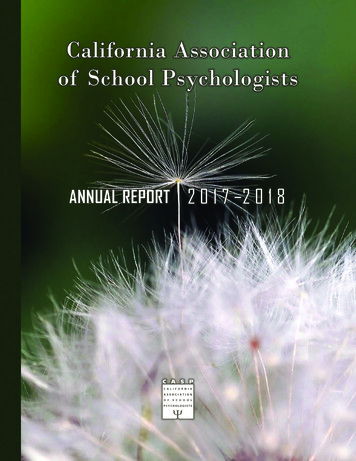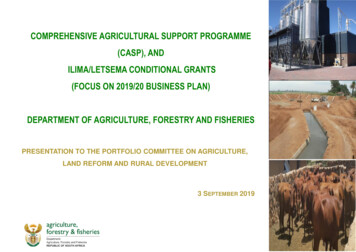
Transcription
COMPREHENSIVE AGRICULTURAL SUPPORT PROGRAMME(CASP), ANDILIMA/LETSEMA CONDITIONAL GRANTS(FOCUS ON 2019/20 BUSINESS PLAN)DEPARTMENT OF AGRICULTURE, FORESTRY AND FISHERIESPRESENTATION TO THE PORTFOLIO COMMITTEE ON AGRICULTURE,LAND REFORM AND RURAL DEVELOPMENT3 SEPTEMBER 2019
Presentation Outline Acronyms Why CASP?o CASP objectiveso CASP pillars and targeted beneficiaries How CASP fits into the National Development Plan : vision 2030 Policy imperatives informing investments Allocations since inception CASP conditional grant framework and 2019/20 Business plan Ilima/Letsema conditional grant framework and Business plan MTEF Allocations and 2019/20 Allocations Disbursement Schedule To What extent are set objectives achieved? Challenges Way Forward2
Acronyms ACB - Agriculture Credit BoardARC – Agriculture Research CouncilAPP – Annual Performance PlanAPS - Agricultural Products StandardsCASP – Comprehensive Agricultural Support ProgramDAFF – Department of Agriculture, Forestry and FisheriesDPME - Department of Planning, Monitoring and EvaluationEC – Eastern CapeGDP - Gross Domestic ProductFMD - Foot and Mouth DiseaseFS – Free StateHSRC - Human Sciences Research CouncilICT - Information and Communication TechnologiesKZN – KwaZulu-NatalLB – Land BankLP – Limpopo3
Acronyms MAFISA – Micro Agricultural Financial Institutions of South AfricaMP - MpumalangaMTEF – Medium Term Expenditure FrameworkNAP – National Assessment PanelNC – Northern CapeNDP - National Development PlanNW – North WestPDA – Provincial Departments of AgriculturePPECB - Perishable Products Export Control BoardRAAVC - Revitalization of Agriculture and Agro-processing Value ChainsSAGAP -South African Good Agricultural PracticesWC – Western Cape4
Why CASP? The Comprehensive Agricultural Support Programme (CASP) was introduced in2004/5 financial year to respond to the gap that resulted following the closure ofthe Agriculture Credit Board (ACB) in 1998, and the broader impacts as related tothe support farmers received from government; The closure of the ACB and reduced support to the ARC led to a situation wherebydirect and indirect support to emerging or small holder farmers would shrink andwithout other instruments and or institutions it became nearly impossible for thenew beneficiaries of Land reform to access credit and or other means of supportfrom commercial banks and the Land bank. The failure to replace the ACB with a similar type of institution with a specificmandate to assist the African smallholder farmers meant that the vast investmentsmade to provide them with land was not fruitful since they were not in a position tocultivate and bring into production their newly inherited land and assets. Also the changes to the marketing environment which had been dominated bymarketing boards and a single channel marketing system meant that theagricultural cooperatives who were farmer based entities consolidated andchanged from agents of the state to privately held companies.5
Why CASP? Commercial farmers had received and benefited from the infrastructure such asstorage, marketing, input supply and extension services provided by thecooperatives which had been funded from state coffers. These were now no moreavailable to service the new emerging black farmers and beneficiaries of LandReform; Considering the historical context – whereby the African farmer of whatever shapeor form had been denied access to resources and support the growing gapbetween them and existing commercial farmers instead of narrowing actually grew. The cooperatives were far from the lands and areas where smallholder farmerswere based and by converting from farmer cooperatives into companies – theAfrican farmers were denied access to their services and support. The Strauss Commission that had spearheaded the revisions and changes to theLandbank and the broader financial landscape had made recommendations whichhad not been implemented to the full. Hence, following a review of therecommendations of the Strauss Commission it was clear that the financial“sunrise” subsidies and the adoption of a “sunrise” package to support thebeneficiaries of the land reform programme requiring finance would require a newinstitutional arrangement and framework leading to the implementation of CASP.6
CASP - ObjectivesCASP sets out to deliver a wide range of economic, social and environmentalbenefits.On the economic front : It is expected to produce higher levels of productive efficiency, create on-farm andoff-farm jobs, increase income and wealth in the rural economy; As the positive impacts of CASP on the agricultural sector gain momentum,significant amounts of domestic and foreign investment will be attracted tocomplement the initial capital injections through the programme; Leading to reversal of the inequities in farmland access and use rights inheritedfrom the apartheid era.7
CASP – Objectives (2)In terms of Social Benefits: Its contributions to household and national food securityshould significantly add to poverty reduction and improverural living standards; reduce crime, violence and sociopolitical instability resulting from conflict over limitedagricultural resources.In terms of Environmental Benefits: Pertaining to environment security, CASP supposedlypromotes ecologically sustainable farming activities.8
CASP – pillars and targeted beneficiaries The programme is delivered through six priority pillars which are:1. On and off farm infrastructure support;2. Knowledge and information management;3. Technical and advisory services;4. Training and capacity building;5. Market and business development support; and6. Financial services (branded MAFISA). Target Populationo The Hungryo Previously disadvantaged subsistence, smallholder and commercial farmerso Entrepreneurso Youth, women and people with disabilities9
How CASP fits into the NDP: Vision 2030Chapter 6: Advocates for an integrated and inclusive rural economy Grow the economy and increase jobs by expanding irrigated agriculture,focusing on: Water use efficiency and New irrigation schemes; Pick and support those industries and regions with the highest growth and jobpotential; Focus on value chains and agro – processing (create jobs and grow the ruraleconomy) Focus on Land Reformo Develop strategies that give new entrants access to value chainso Find creative combinations between opportunities, e.g. Support successful communal farmers – security of tenure Collaboration between commercial and land reform beneficiaries10
Policy imperatives informing investments1.Potential to Create 1 million jobs by 2030 (National Development Plan)2.Expand commercial agriculture to achieve 250 000 direct jobs and 130 000 indirectjobs by 2030 (support 450 black commercial farmers)3.Put 1 million hectares of unutilised land under production by 2019 (Fetsa Tlala)4.Support 300 000 smallholder producers by 2019 (New Growth Path)5.Expand 1.5 million hectares under irrigation by 500 000 (NDP: 2030 Vision)6.Ensure food security for all (Act 108 of 1996, Constitutional Mandate)7.Ensure sustainable use of natural resources8.Grow agricultural contribution to the GDP - driven by the Revitalization of Agricultureand Agro-processing Value Chains (RAAVC – 9 point plan) – throughoperationalization of the Agriculture Policy Action Plan.11
The impact study on CASP for a period2007/08 – 2011/12 was conducted by DAFFand DPME in 2014/15.Allocations since inceptionYearCASPAllocationExpenditure% SpendingNumber 236251046 5002005/2006250157631 07053 2002006/20073002528487067 4002007/20084153338078660 3002008/20095354027570331 0392009/20107156939788826 2662010/2011862854991 27127 9722011/20121 029984948142012/20131 5341 260812013/20141 6001 6002014/20151 otalProvince 000%2008/09171 000171 000171 000147 000864112009/1050 00050 00050 00067 00013412 9672010/11200 000192 000192 000191 00099.575 2072011/12400 000400 000400 000396 00099109 1972012/13415 000415 000415 000400 00096.4162 98536 5042013/14438 000438 000454 000424 00093.4147 99053659 2862014/15460 000460 000487 521484 08499.3191 39610075365 0752015/16470 768466 713466 713464 26999.5173 0191 39498804113 2571 6511 63099.71 54742 8692016/17491 363491 363491 363481 43598170 7762016/20171 6411 57295.440025 9582017/18522 139522 139522 139487 54393.3186 2432017/20181 6451 4468846822 906552 423552 423552 423524 93991.12018/2019TOTAL1 750 8101 892 56190.914 23812 70086.82018/1911 420678 532TOTAL4 170 693 4 158 638 4 202 159 4 067 2701296.8
CASP Conditional Grant FrameworkGrant GoalTo create a favourable and supportive agricultural services environment for thefarming community, in particular subsistence, smallholder and black commercialfarmers within strategically identified grain, livestock and horticulture production areas.Grant Purposeo To provide effective agricultural support services, promote and facilitate agriculturaldevelopment by targeting beneficiaries of land reform, restitution and redistribution, andother black producers who have acquired land through private means and are engagedin value-adding enterprises domestically, or involved in export.o To address damage to infrastructure caused by floods.o To revitalize agricultural colleges into centers of excellence.13
CASP Conditional Grant Framework (2)Outcome statementso Broadened access to agricultural support for black subsistence, smallholderand commercial farmers;o Increased number of sustainable and profitable black producers inhorticulture, grains, livestock, and aquaculture value chains;o Improved farming efficiency;o Improved systems required for the maintenance of a Foot and Mouth Disease(FMD) free status as prescribed by the World Organisation for Animal Health;o Increased wealth creation, and sustainable employment in rural areas;o Increased access to markets by beneficiaries of CASP;o Improved household and national food security;o Reliable and accurate agricultural information available for managementdecision making.14
CASP 2019/20 Business PlanGrant OutcomeBroadened access to agricultural support for blacksubsistence, smallholder and commercial farmersOutcome Indicator Number of subsistence farmerssupported with production inputs andmechanisation1 433Number of smallholder farmerssupported with production inputs andmechanisation6 111Number of black commercial farmerssupported with production inputs154Number of projects supported43715
CASP 2019/20 Business PlanGrant OutcomeImproved farming efficiencyOutcome Indicator Number of farmers trained26 806Number of farmers r of extension personnelprovided with resources (e.g ICTinfrastructure)Number of colleges revitalised1443 2681016
CASP 2019/20 Business PlanMaximize Job OpportunityGrantOutcomeOutcome Number of jobs createdIndicatorProvinceJobsTotal jobsECFSGPKZNLPMPNCNWWC1 343210921 9249864043906481 1597 15617
SAGAP Certification programme DAFF in partnership with PPECB and Provinces are implementing theSouth African Good Agricultural Practices (SAGAP) certificationprogramme for smallholder producers of fresh produce since January2014. In the initial stages of implementation DAFF (Marketing andSmallholder Directorates) with PPECB carried the costs for theprogramme; and CASP only addressed non-conformances relating toinfrastructure. In 2018/19 provinces were requested to enter into agreements withPPECB and carry all the costs of the programme through CASP,addressing both soft and hard non-compliances (i.e. pre-audits,training/workshops and infrastructure development); as outlined inRegulation 707 of 2005 under the Agricultural Products Standards(APS) Act of 1990.18
SAGAP Certification - Progress made to dateProvinceNumberParticipatingCertified CertifiedTotalPre-Audits Final Audits (Primary (On farmCertifiedProduction) Packhouse)NumberNumberMaintaining2019/20Failed n Cape17170000001 104Free State1414000000300Gauteng27267549101 460KwaZulu Natal12121112103 000Limpopo272732131013 789Mpumalanga26231110111801 500Northern Cape119626554054540250North West15151101013 000Western Cape1814551610800275210937888666125 20344%37%4%41%31%0%Total%19
Placement of unemployed graduates in commercial farms2019/20ProvinceNo. GraduatesStipend (Year 1)per graduateTotal BudgetEastern Cape12091 35010 962 000Free State12091 35010 962 000Gauteng8087 5006 960 000KwaZulu natal12091 35010 440 000Limpopo12091 35010 962 000Mpumalanga12091 35010 440 000Northern Cape8087 5007 000 000North West12091 35010 962 000Western Cape12091 35010 962 000Total1 00089 650 00020
CASP 2019/20 Business PlanGrant OutcomeImproved systems required for the maintenanceof a Foot and Mouth Disease (FMD) free status inLimpopo, KwaZulu Natal and Mpumalang asprescribed by the World Organisation for AnimalHealthKZN600 Vaccinations done in KZN2 000 (25km fencing)LP37 000 Vaccinations done in LP6 050 (20 Cattle grids, 20 farm gates and 130kmfencing erected).MPVaccinations through equitable share.Total BudgetR8 650 00021
KyD (Kaonafatso ya Diphoofolo)GraduatesNumber offarmersNumber ofAuctionEventsNumber ofFarmers Day3 661480068FS3 661480025GP3 661480025KZN5 59364 0001210LP4 04042 40068MP3 66141 80068NC3 661480025NW3 66141 80068WC2 041450004Total33 6403813 7004261Budget(R'000)ECProvince22
Ilima/Letsema Conditional Grant FrameworkGrant GoalTo reduce poverty through increased food production initiativesGrant PurposeTo assist vulnerable South African farming communities to achieve an increase in agriculturalproduction and invest in infrastructure that unlocks production within strategically identified grain,livestock, horticulture and aquaculture production areas.Outcome statementso Increased production of grains, livestock, horticulture and aquaculture at both householdand national level;o Improved household and national food security;o Improved farm income;o Maximised job opportunities;o Reduced poverty;o Rehabilitated and expanded irrigation schemes.23
Ilima/Letsema 2019/20 Business PlanGrant OutcomeOutcome IndicatorIncreased agricultural production of grains, livestock,horticulture and aquaculture at both household andnational levelHectares planned92 802 haYield per unit area (average 3 tons) 278 406 tonsHa40 00035 00030 00025 00020 000Ha15 00010 0005 0000HaECFSGPKZNLPMPNCNWWC35 8099 5112 0005 30014 33911 2621 469,0012 91220024
Commodities Prioritized (95% grains in 2019/20)25
Ilima/Letsema 2019/20 Business PlanGrant OutcomeImproved households and national food securityOutcome Indicator Number of households supportedwith inputs for vegetable gardensNumber of school gardens supportedNumber ofsupportedcommunity67 61216gardens1 040Number of subsistence farmerssupported with production inputs andmechanisation31 978Number of smallholder farmerssupported with production inputs andmechanisation7 257Number of black commercial farmerssupported with production inputs203Vulnerability Assessment SurveysConducted in 9 provincesR45 76826
Ilima/Letsema 2019/20 Business PlanMaximize Job OpportunityGrantOutcomeOutcome Number of jobs createdIndicatorProvinceJobsTotal jobsECFS1 801 13 333GPKZNLP632 600 4 609MPNCNWWC1466101199923 38027
Ilima/Letsema 2019/20 Business PlanGrant OutcomeRehabilitated and expanded irrigation schemes.ofOutcome Indicator NumberrevitalisedIrrigationschemes7IRRIGATION SCHEMER’000Keiskammahoek6 549Eerde Koning (lower Keiskammahoek)2 000Qamata8 299Makhathini31 500Pongola2 976NWTaung7 101NCVaalharts15 000PROVINCEECKZNTotal73 42528
Summary Business Plans for 2019/20 Financial YearCASP Targets Total allocation R1, 538 325 billion1433 Subsistence farmers supported6111 Smallholder farmers supported13 700 Smallholder farmers participating in KYD154 Commercial farmers supported437 projects supported26 806 Farmers trained, 642 farmers mentored7 156 jobs targeted10 Colleges of Agriculture revitalized (ongoing)Smallholder farmers SAGAP Certified and linked tomarketsFarmers affected by flood disasters supported inLimpopo, Mpumalanga and Western CapeR 368 million allocated for Extension RecoveryPlan (Training, Resources, Salaries)Revitalize Taung, Vaalhaarts, Makhathini, Pongola,Keiskammahoek, Eerde Koning and Qamatairrigation schemesImprove systems towards FMD free status inLimpopo, Mpumalanga and KwaZulu NatalILIMA/LETSEMA Targets Total allocation R583 million511 projects approved67 612 Vulnerable households supported withstarter packs to produce own food (food gardens)Vulnerability Assessment Survey conducted in 9provinces in partnership with HSRC16 School gardens supported1 040 Community gardens supported31 978 Subsistence farmers supported (1ha)7 257 Smallholder farmers supported203 Commercial farmers supported92 802 ha planted; average yield of 3ton/ha23 380 Jobs created29
MTEF AllocationsConditional Grants2019/202020/212021/221 538 3251 675 9891 813 718583 359615 444652 9862 121 6842 291 4332 466 704Blended Funding (LB)271 469295 763320 068Blended Funding (Smallholder) (LB)150 000Total transfer to LB421 469295 763320 0682 543 1532 587 1962 786 772CASPIlima/LetsemaTotal conditional grant (NAP - PDA)Total grantsTotal MTEF transfer to PDA’s R6, 879 821 BillionTotal MTEF transfer to LB R1, 037 300 BillionTotal 2019//20 – 2021/22 MTEF allocation R7, 917 121 Billion30
CASP Allocation R'000R'000R'000R'000R'000Eastern Cape244 101143 33884 36216 401Free State168 373130 19229 2998 882Gauteng91 30674 89116 4150KwaZulu-Natal199 351138 60648 44012 305Limpopo246 542137 49282 38318 4158 252Mpumalanga154 076117 21628 29508 565Northern Cape119 45890 51128 9470North West164 857123 38926 53814 930Western Cape150 26177 21823 8795 63243 5321 538 3251 032 853368 55876 56560 349ProvinceTotal31
Ilima/Letsema R'000R'000R'000Eastern Cape75 2548 62766 627Free State70 5863 48267 104Gauteng31 9741 65130 323KwaZulu-Natal75 2533 45171 802Limpopo75 2546 15169 103Mpumalanga61 5045 25156 253Northern Cape64 1692 77761 392North West70 5864 57766 009Western Cape58 7799 30149 478583 35945 268538 091Total32
Approved Disbursement PROVINCE17-May-19 30-Aug-19 31-Oct-1931-Jan-20Eastern Cape15%35%30%20%Free %Northern North West10%35%35%20%WC20%40%30%10%Western 33
To what extent are the set goals achieved? Some Findings from the Impact Study conducted in 2014/15:o The Comprehensive Agricultural Support Program (CASP) has significantlycontributed towards growth and the sustainability of individual smallholderfarming enterprises supported. Incomes of Project / Farm managers increased after CASP, Jobs increased and were sustained after CASP, 85% of CASP beneficiaries have access to markets Average area cultivated increased after CASP.o The proportion of youth supported was low, 14% of total beneficiaries were youtho Access to agricultural information increased after CASP and more than 77%of beneficiaries indicated medium to high satisfaction on information received.o Farmers were generally satisfied with the quality of Extension Serviceso CASP has made a significant contribution to on-farm infrastructure andlivestock in all nine provinces.34
Weaknesses / Challenges Insufficient integration of CASP into the Department of Agriculture,Forestry and Fisheries. Repeated audit findings regarding inadequate monitoring of fundedprojects. Misalignment in reporting timelines – CASP and Ilima/Letsema isgoverned by the Division of Revenue Act – and its reporting timelinesare not the same as the APP reporting timelines.35
Way Forward A process to integrate CASP into the Department has already begun. All Development Funds will be managed from the office of the ChiefFinancial Office, Monitoring and Evaluation of CASP projects will bedone from the Branch : Policy, Planning and Monitoring andEvaluation and all other Pillars of CASP will be located in therelevant Units of the Department. We have re-assigned within the Department, 18 Assistant Directors tomonitor CASP projects in the Provinces. The 1000 unemployed graduates that are placed in the CommodityGroups will also be used to monitor CASP on a quarterly basis. To this effect programmes shall be headed by the relevant ChiefDirectors who will regularly interact with the Provinces about theimplementation measures, monitoring and evaluation of projects witha strong focus in the planning of programmes.36
Way Forward Develop an Integrated Producer Support Model to respond to thepreliminary recommendations from the CASP Impact study that stated: “The most effective and efficient way to support farmers inSouth Africa is to overhaul and redesign all farmer supportprogrammes and do away with existing silos of farmer support.This should entail the establishment of a single programme of farmersupport to replace the numerous programmes which currently exist.”37
THANK YOU38
CASP -Comprehensive Agricultural Support Program DAFF -Department of Agriculture, Forestry and Fisheries DPME - Department of Planning, Monitoring and Evaluation . The impact study on CASP for a period 2007/08 -2011/12 was conducted by DAFF and DPME in 2014/15. Year CASP Allocation Expenditure % Spending Number of projects .
